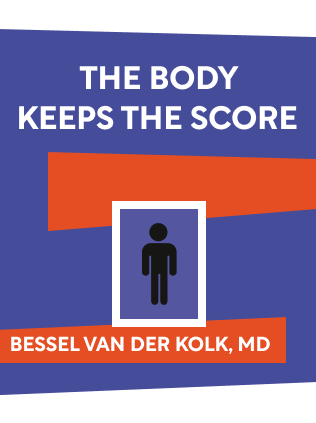

This article is an excerpt from the Shortform book guide to "The Body Keeps The Score" by Bessel van der Kolk. Shortform has the world's best summaries and analyses of books you should be reading.
Like this article? Sign up for a free trial here .
Did you read The Body Keeps the Score? How well did you internalize the concepts?
Experiences such as abuse, a severe car accident, and wartime combat can lead to a lifetime of flashbacks, nightmares, isolation, insomnia, hypervigilance, and rage. In The Body Keeps the Score, Bessel van der Kolk explores how diagnosing and treating trauma has evolved.
Keep reading for nine The Body Keeps the Score quizzes that test your knowledge of the book.
The Body Keeps the Score Quizzes
Van der Kolk explains that trauma’s impact is not only mental, emotional, and neurological; it’s also physiological: Trauma rewires the brain to put people in a constant state of stress or numbness, leading to a host of physical problems.
Take these nine The Body Keeps the Score quizzes individually or with a group to reinforce what you learned in the book.
Quiz #1: Defining Trauma
Trauma has many causes and presentations, so there was no single diagnosis for trauma until 1980. Creating that diagnosis opened the door for further research and more effective treatment options.
Question #1: Which of the following is a symptom of trauma?
- Flashbacks
- Nightmares
- Rage
- All of the above
Answer & Explanation
Option 4 is correct. Symptoms of trauma include flashbacks; nightmares; avoidance of people, places, or thoughts connected to the trauma; hyperarousal, including hypervigilance, insomnia, and intense rage; periods of emotional collapse; and difficulty maintaining meaningful relationships.
Question #2: Trauma affects survivors _______.
- Emotionally
- Neurologically
- Physiologically
- All of the above
Answer & Explanation
Option 4 is correct. Trauma’s impact is three-pronged: It affects the mind (mental/emotional), brain (neurological), and body (physiological).
Question #3: What kind of behavior do untreated PTSD sufferers not typically engage in to calm their nerves?
- Relaxing activities such as walking and gardening
- Drinking
- Dangerous activities such as driving at high speeds
- Drug use
Answer & Explanation
Option 1 is correct. Until they learn coping methods through treatment, PTSD sufferers—like Tom the Vietnam veteran—often feel calm only when they’re engaging in high-risk activities such as driving at dangerous speeds, which gives them a sense of control amid chaos, or drinking or using drugs to numb their pain and anxiety.
Question #4: What is the primary concern with the DSM not including accurate diagnoses for trauma survivors who don’t fit the definition of PTSD?
- Those patients won’t know what to call their condition.
- It makes it difficult to make insurance claims.
- Inaccurate diagnoses lead to ineffective treatments.
- Doctors might not believe those patients.
Answer & Explanation
Option 3 is correct. If the DSM doesn’t include diagnoses trauma sufferers who don’t fit the definition of PTSD, they will receive inaccurate diagnoses and consequently get treatment that doesn’t address their needs.
Quiz #2: Trauma’s Emotional Impacts
Trauma survivors struggle with many social and emotional issues, from haunting flashbacks to difficulty forming and maintaining relationships.
Question #1: Which of these is not a factor in trauma survivors’ struggle to have intimate relationships?
- Difficulty trusting people after experiencing the betrayal and pain of abuse
- Feeling that no one could possibly understand what they’ve been through
- Overwhelming shame at how they acted during the trauma
- Other people are scared away by survivors’ stories of their traumas
Answer & Explanation
Option 4 is correct. One of the lasting impacts of trauma is an inability to develop intimate relationships with others: After experiencing such suffering at the hands of another person, how can you trust anyone again? And how can anyone possibly understand how you feel? Additionally, Many trauma survivors are even more haunted by shame at what they did or didn’t do during the traumatic event—whether or not they could’ve realistically acted any differently—than by the atrocity of their abusers’ actions.
Although some trauma survivors do experience negative feedback when they open up about their experiences, this is not a common roadblock to developing close relationships—often, the issues above prevent trauma sufferers from sharing their experiences in the first place.
Question #2: What can trigger a flashback?
- An image that reminds you of the traumatic event
- A word or phrase your abuser said
- The smell of the cologne your abuser wore
- All of the above
Answer & Explanation
Option 4 is correct. Long after the trauma is over, seemingly ordinary things can trigger flashbacks—a particular smell, a word or phrase, a physical position, or an image that is somehow associated with the traumatic event.
Question #3: How can trauma affect your imagination?
- You lose your ability to dream.
- You see images from your trauma in everyday objects.
- You start to inhabit an imaginary world to escape your traumatic memories.
- You can’t come up with believable lies.
Answer & Explanation
Option 2 is correct. Trauma victims can stop allowing their imagination to wander and interpret meaning from ordinary things, or they can superimpose images from the traumatic memories onto ordinary objects and situations, instead of letting their minds create new meaning.
Question #4: True or false: You can become addicted to trauma.
- True
- False
Answer & Explanation
Option 1 is correct. There’s a theory that people can become addicted to endorphins, the chemicals secreted in the brain in times of stress (e.g., during traumatic events). The body adjusts and creates a new equilibrium, making trauma survivors feel symptoms of withdrawal when they’re not in stressful situations.
Question #5: What causes people to develop learned helplessness and give up trying to escape bad situations or improve their circumstances?
- Laziness
- Negative thought patterns
- Immobilization during trauma
- Fear of failure
Answer & Explanation
Option 3 is correct. Immobilization is the inability to escape, protect yourself, or process the event—whether you are physically held down during abuse, stuck in a car during an accident, or in a war zone with nowhere to escape the violence. People who are immobilized remain stuck in a state of shock and helplessness and are unable to move on after the event.
After suffering inescapable trauma, many trauma survivors develop learned helplessness and give up on trying to escape or improve their circumstances in any situation. Trauma has curbed their fight-or-flight instinct, and instead of risking the unknown, they remain in the familiar fear.
Quiz #3: How the Brain Processes Trauma
Trauma is so overwhelming that parts of the brain shut down while others are over-stimulated. All this affects how the brain processes and stores the memory of the traumatic event.
Question #1: What does a flashback feel like?
- Reliving the trauma in a trance-like state
- Repeatedly going over the traumatic event, from beginning to end
- Flashes of sensory memories—such as sounds, smells, or images—from the trauma
- A tingling sensation in the body part affected by the trauma
Answer & Explanation
Option 3 is correct. Traumatic events are processed as fragments of sensory information—sounds, smells, sensations, and images—instead of a coherent narrative. These fragmented sensory memories are what return during flashbacks.
Question #2: Traumatic experiences and flashbacks make the brain’s speech control center go offline. What’s the consequence of this?
- You temporarily become mute.
- You start talking in gibberish.
- You’re unable to understand people who are speaking to you.
- You struggle to put the facts of the trauma and your feelings about it into words.
Answer & Explanation
Option 4 is correct. The brain’s speech control center, called Broca’s area, is key to articulating thoughts and feelings. Trauma survivors struggle to express what happened and can’t put their feelings into words.
Question #3: What’s the consequence of the right hemisphere of the brain activating during a flashback while the left hemisphere shuts down?
- You become physically uncoordinated.
- You can’t process the experience so the brain acts as if the traumatic event is happening in the present.
- The disconnection makes you forget the traumatic event.
- You lose the ability to speak.
Answer & Explanation
Option 2 is correct. When the two hemispheres are disconnected, people can’t process experiences, grasp cause and effect, understand long-term consequences, or make plans for the future. When a flashback is triggered, the right brain acts as if the traumatic event is occurring in the present, and the left is unable to provide the logic that it’s merely a reenactment of the past. This leaves trauma survivors unable to process their traumatic experience and integrate it into the timeline of their lives.
Question #4: How does stress or fear impact your memory?
- You remember the event better unless it’s so overwhelming that you shut down.
- You try to shut it out and don’t remember stressful or scary events.
- Your brain causes you to remember the details wrong.
- You remember stressful or scary events just as well as anything else.
Answer & Explanation
Option 1 is correct. Events that cause a negative reaction such as stress, fear, or dislike—triggering the body to release adrenaline—are preserved best in your memory. Up to a point, the more adrenaline your body secretes, the better you remember the event (even if you don’t remember all the details, you’ll vividly recall how it made you feel). However, if the experience is overwhelmingly terrifying and inescapable, your body shuts down in response.
Quiz #4: Brain Anatomy
There are three parts of your brain, each responsible for different functions. Understanding them better helps to understand how trauma affects the brain.
Question #1: What functions does the reptilian brain manage?
- Sunbathing
- Basic needs (e.g., breathing, eating, sleeping)
- Communicating emotions
- Logic
Answer & Explanation
Option 2 is correct. The reptilian brain is the most primitive part of your brain and develops while you’re in the womb. It’s responsible for the things babies can do: breathe, eat, sleep, wake, cry, feel temperature, sense hunger, feel pain, urinate, and defecate.
Question #2: Which of these is not controlled by the limbic system?
- Watching for danger
- Navigating social networks
- Emotional responses
- Sensing hunger
Answer & Explanation
Option 4 is correct. This limbic system houses emotions, watches for danger, detects joy or fear, decides what’s important for survival, and manages how you navigate complex social networks.
Question #3: How does trauma affect the emotional brain?
- Trauma makes the emotional brain hyperreactive to perceived threats.
- Trauma numbs the emotional brain.
- Trauma makes the emotional brain react slower than the rational brain.
- Trauma has no impact on the emotional brain.
Answer & Explanation
Option 1 is correct. The emotional brain jump-starts your preprogrammed reactions, like the fight-or-flight response, which get your body in motion before you have time to think or plan. Trauma alters the emotional brain’s ability to accurately and effectively perceive threats, so trauma survivors go through life constantly jumping in response to non-threats.
Question #4: What’s the role of the amygdala, or the brain’s smoke detector?
- Alert the body to stay away from intense heat
- Trigger the muscles that help you scream and be loud
- Judge if there’s a threat and sounds the alarm to trigger stress hormones
- Weigh in with rational thinking
Answer & Explanation
Option 3 is correct. The amygdala quickly determines whether the information qualifies as a threat. If the amygdala deems something to be a threat, it triggers the stress-hormone system and ANS to release stress hormones, including cortisol and adrenaline. This raises your heart rate, blood pressure, and rate of breathing to get your body ready for fight or flight.
Question #5: What’s the role of the MPFC, or the watchtower?
- Use logic to balance the emotional brain’s reaction
- Help you taste food
- Look out for danger
- Sound the alarm in the case of a threat
Answer & Explanation
Option 1 is correct. The MPFC acts as the watchtower, where logic can weigh in and let you know to calm down if you misjudged a perceived threat. If the MPFC determines that there is, in fact, no real threat, it stops the stress hormones and preprogrammed response that the amygdala triggered.
Quiz #5: Levels of Safety
There are three levels of safety when you’re faced with a threat, each one progressively stressful: If your response at one level doesn’t get you out of the situation, you elevate to the next level.
Question #1: What are your means of escaping a bad situation at level 1?
- You call to others for help.
- You run as fast as you can.
- You curl up in a ball.
- You try to fight off the threat.
Answer & Explanation
Option 1 is correct. The first level is social engagement, meaning that you call to others for help and comfort. At this level, the VVC is coordinating your facial muscles to communicate your distress to others through facial and verbal expressions.
Question #2: When do you resort to fight or flight?
- Level 1
- Level 2
- Level 3
- Never
Answer & Explanation
Option 2 is correct. If no one responds or there’s no time to call for help, you reach the second level: fight or flight. Your mammalian brain triggers adrenaline to increase your heart rate and blood pressure to prepare your body for swift action.
Question #3: What happens when you collapse?
- Your muscles give out.
- You die.
- Your metabolism and breathing slow and you dissociate from yourself.
- You pass out.
Answer & Explanation
Option 3 is correct. Collapse causes you to shut down—the most basic form of survival in the face of inescapable circumstances. In times of collapse, the DVC slows metabolism, makes your breathing shallow, and even empties your bowels. In this state, you dissociate from yourself and may not even be aware of pain.
Question #4: What level(s) of safety have trauma sufferers most likely experienced if they struggle with social relationships?
- Level 1
- Level 3
- Levels 1 and 2
- Levels 2 and 3
Answer & Explanation
Option 4 is correct. In order to re-engage in social relationships and community, trauma survivors who have had level 2 and 3 reactions need help rewiring their brain’s and body’s responses from the hypervigilance or collapse that helped them survive their traumatic events.
Quiz #6: Caregivers Shape a Lifetime of Relationships
From the very first days of your life—before you can even remember—you’re learning critical, lifelong lessons through your relationship with your caregiver.
Question #1: Why is attachment so important for babies?
- It keeps them from crying.
- It helps them learn language.
- It determines how well they’ll take care of themselves and others.
- It teaches them right and wrong.
Answer & Explanation
Option 3 is correct. Your attachment—how well your caregivers meet your needs—determines how well you’ll take care of these needs for yourself later in life. Furthermore, the more responsive your caregivers are to you, the more responsive you’ll be to others.
Question #2: Which of these is not something a secure attachment instills in children?
- What makes them and others feel good or bad
- Resilience
- A sense of agency
- How to make other people do what they want
Answer & Explanation
Option 4 is correct. Children with secure attachments learn to identify what makes them and others feel good or bad. Securely attached children are most resilient in the face of life’s challenges: They understand when they have control over a situation and when things are out of their hands, and they have a sense of agency, giving them the confidence that they have control over their actions and can impact their circumstances.
Question #3: Avoidant attachment and anxious (or ambivalent) attachment are both forms of what kind of attachment?
- Insecure attachment
- Unstable attachment
- Disorganized attachment
- Dysfunctional attachment
Answer & Explanation
Option 1 is correct. Avoidant and anxious (or ambivalent) attachments are both forms of insecure attachment. These, as well as secure attachment, are all considered “organized” attachments because they respond to a consistent style of caregiving; although the two forms of insecure attachments create issues, they provide some stability.
Question #4: What is the purpose of inner maps?
- They give you direction in life.
- They determine how you engage with people and the world.
- They are your foundation for academic learning.
- They give you a sense of spatial orientation.
Answer & Explanation
Option 2 is correct. Attachment, childhood experiences, and childhood traumas shape your inner maps of the world. As an adult, your inner map determines what you consider normal and familiar, how you interpret situations, and how you engage with the people and world around you: If something falls in line with your inner map, it must be right—whether it’s abuse and mistreatment or love and appreciation.
Question #5: How can a stressful or traumatic childhood environment (the “nurture” side of nature vs. nurture) affect your genes?
- It can’t.
- By making your brain shut down temporarily.
- By building up your resilience to stressful situations.
- By switching on certain genes that make you more susceptible to stress.
Answer & Explanation
Option 4 is correct. Life experiences can switch on or off certain genes to make them react differently to emotions and experiences. In other words, stressful experiences can make you more susceptible to subsequent stress.
Quiz #7: The Limits of Talking it Out
When you think of therapy and psychological treatment, traditional talk therapy might come to mind. But this approach alone doesn’t heal all of trauma sufferers’ symptoms.
Question #1: Why are forms of exposure therapy—like CBT—inadequate for trauma survivors?
- It can retraumatize the patient.
- It can increase the patient’s fixation on the trauma.
- Trauma sufferers often struggle to articulate what happened to them.
- All of the above
Answer & Explanation
Option 4 is correct. If the patient isn’t yet ready to cope with the emotions that come up, talk therapy can retraumatize her and increase her fixation on the trauma. What’s more, it can be difficult for trauma survivors to articulate what happened to them, because their brains didn’t process the event as a coherent narrative but rather as a collection of fragmented sensations.
Question #2: Which of the following is not a reason that talk therapy is an important component of trauma survivors’ treatment?
- Talking breaks the isolation of keeping such a traumatizing secret.
- Opening up to others allows you to feel heard and understood.
- Sharing your secret increases the likelihood that your abuser will be punished.
- Talking about the trauma relieves all the energy it takes to suppress the emotions attached to the trauma.
Answer & Explanation
Option 3 is correct. First, talking about your trauma breaks the silence and isolation of keeping it a secret. Second, talking about your experience and emotions relieves the incredible amount of energy and attention required to suppress them and allows you to work through your psychological wounds by acknowledging them. Third, when you open up to other people, you create the opportunity to feel heard and understood, which activates your limbic brain and helps in the physiological healing process.
Question #3: Trauma causes the brain’s speech control center to shut down, so it can be extremely difficult to find words to describe the event and your feelings about it. What are some other ways trauma survivors can express themselves?
- Body awareness
- Art, music, or dancing
- Free writing
- All of the above
Answer & Explanation
Option 4 is correct. First, you can notice your physical sensations, which can clue you in to the emotions behind those sensations. Second, art—including drawing, painting, music, and dance—can be an expressive outlet for your feelings. Third, free writing (writing your stream of consciousness without stopping or self-editing) lets you express yourself without worrying about what anyone else will think—or if it even makes sense.
Question #4: In IFS therapy, who must ultimately take control of all the parts in order to heal?
- The inner Self
- The therapist
- The exile
- The firefighter
Answer & Explanation
Option 1 is correct. IFS approaches healing through developing self-leadership of your parts. IFS takes the view that the parts have protected an undamaged inner Self. Through mindfulness, the Self must then take on the leadership of all the parts, making sure each one heals and regularly has its needs met through self-reflection, exploration, and self-care.
Quiz #8: The Drug Revolution
The development of psychiatric drugs and the field of pharmacology changed the way psychiatrists diagnosed and treated mental and emotional issues.
Question #1: What is the “model” of thinking that relies on psychiatric drugs and led to the development of the field of pharmacology?
- The drug model
- The brain-disease model
- The brain chemistry model
- The pharmaceutical model
Answer & Explanation
Option 2 is correct. The brain-disease model is the basis for pharmacology and views mental problems as “disorders” that could be treated with drugs to adjust brain chemistry.
Question #2: What is a benefit of introducing medications into psychiatry?
- Doctors had another tool besides talk therapy.
- Drugs cured most mental disorders.
- Medications gave patients control over their own healing process.
- Pharmaceutical sales funded studies of non-drug-related treatments.
Answer & Explanation
Option 1 is correct. Medications gave doctors another tool besides talk therapy and can be useful for controlling emotions and behaviors. However, while drugs can treat symptoms of trauma, they can’t heal trauma without also incorporating other forms of treatment.
Question #3: Which of the following is not a negative consequence of the introduction of psychiatric drugs?
- Drugs became a substitute for therapy.
- Medications often treat symptoms without addressing the root problem.
- Most psychiatrists are reluctant to prescribe medications.
- Patients rely on drugs instead of feeling empowered in their own healing process.
Answer & Explanation
Option 3 is correct. The availability of drugs has become a substitution for therapy in many instances and allowed patients to treat their symptoms without addressing the root problems. Reliance on medication also prevents patients from feeling empowered in their own healing and instead places the power in the hands of the prescribing doctors and insurance companies.
Question #4: Which recreational drug has actually shown to be effective in helping to treat trauma sufferers?
- Marijuana
- Ecstasy
- Cocaine
- Heroin
Answer & Explanation
Option 2 is correct. Ecstasy, or MDMA, raises your self-awareness while decreasing fear, defensiveness, and numbing; this combination made it a great fit for trauma patients. Several studies using MDMA to aid in trauma sufferers’ psychotherapy had positive short- and long-term results, but it must be used carefully and in tandem with therapy.
Quiz #9: Bottom-Up Treatment Options
The bottom-up approach to therapy engages patients physically so they can understand and learn to master the connection between their physical sensations and their emotions.
Question #1: What makes eye movement desensitization and reprocessing (EMDR) different than other forms of therapy?
- Patients don’t have to say a word during therapy.
- Patients don’t have to trust the therapist.
- Patients don’t have to speak the same language as the therapist.
- All of the above
Answer & Explanation
Option 4 is correct. Unlike other forms of therapy, EMDR patients don’t have to verbalize the memories they’re having in order for EMDR to work; they can go through the whole process without saying a word—they don’t even have to speak the same language as the therapist, as long as the therapist can communicate encouragement and to stay with a thought or feeling. Additionally, an EMDR patient doesn’t need to trust or even like her therapist in order for the treatment to be effective. This makes EMDR especially valuable for trauma survivors, who often struggle to trust others.
Question #2: Which of the following is not a method to improve your HRV?
- Running
- Yoga
- Smartphone apps
- Special devices
Answer & Explanation
Option 1 is correct. You can train yourself to change your breathing (and thus improve your HRV) through yoga as well as certain devices and smartphone apps.
Question #3: True or false: Yoga can rewire trauma survivors’ brains to help with their healing.
- True
- False
Answer & Explanation
Option 1 is correct. Yoga’s positive effects can even be seen in the brain: A study of women with histories of intense trauma found that 20 weeks of yoga increased activity in the insula and medial prefrontal cortex (MPFC), where trauma survivors typically have abnormally low activity. The insula takes sensory information and signals the amygdala if it needs to trigger a fight-or-flight response, and the MPFC is the watchtower that logically weighs information and balances out the response of the amygdala (the smoke detector). In other words, yoga strengthens the parts of the brain that help prevent you from overreacting to minor threats.
Question #4: What roles do other group members play in PBSP (psychomotor) therapy?
- Contact person
- Characters from the protagonist’s story
- Ideal versions of characters from the protagonist’s story
- All of the above
Answer & Explanation
Option 4 is correct. Group members can be chosen to be a contact person—to sit beside the protagonist to offer comfort and support—as well as characters from the protagonist’s story and ideal versions of those characters. This allows the protagonist to say things they couldn’t say during the actual events, and to hear things (such as healing, affirming statements) that the real people never said.
Question #5: How does neurofeedback affect patients’ brain circuitry?
- By electrocuting them every time they think of their trauma
- By shutting down some parts of the brain
- By mirroring back brain waves to encourage certain frequencies
- None of the above
Answer & Explanation
Option 3 is correct. Neurofeedback is a method that involves hooking up patients to machines that track their brain waves and mirror them back in order to encourage certain frequencies and brain patterns while discouraging others. Neurofeedback is also able to target frequencies in certain areas of the brain in order to increase focus, alertness, and other states.
Question #6: Why is acting therapeutic for trauma sufferers?
- They can escape their reality and embody another character.
- They have to practice full physical control.
- They benefit from being an important, contributing member of a group.
- All of the above
Answer & Explanation
Option 4 is correct. First, acting gives patients a chance to escape from the ailments, circumstances, and feelings they face every day and embody a different character—someone strong, resilient, and confident. Second, actors must be in full control of their bodies and their physical expressions; feeling that you have full control and ownership of your body is key to having a sense of agency, a necessary aspect of healing for trauma survivors. Third, being part of a theatrical production makes patients valuable, contributing members of a community (in this case, the theater group), which helps them regain a sense of worth and competence.

———End of Preview———
Like what you just read? Read the rest of the world's best book summary and analysis of Bessel van der Kolk's "The Body Keeps The Score" at Shortform .
Here's what you'll find in our full The Body Keeps The Score summary :
- How your past trauma might change your brain and body
- What you can do to help your brain and body heal
- Why some trauma survivors can't recognize themselves in the mirror






